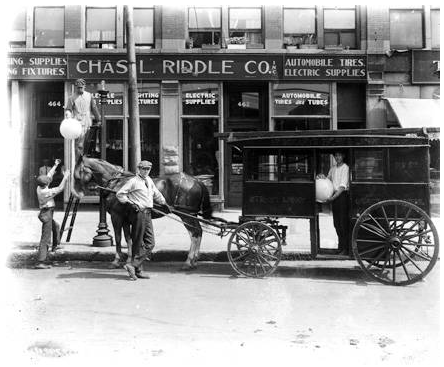Copied from the Old Northside Historic Plan, information on our house:
Caylor – Jenkins – Riddle House
c. 1876
Built by Joseph Caylor, who lived next door, this Italianate cottage has had its original frame porch replaced by the present brick porch with battered columns. The window sash has also been changed to four over one. These changes were probably made after 1910.Dennis Jenkins took up residence at this address in 1890. He was publisher of the Jersey Bulletin, a publication for Jersey cattle breeders. A permanent memorial to Jenkins exists in the form of the bell at Irvington Presbyterian Church, which he donated upon its construction.
From 1919 to 1925, Charles L. Riddle, Jr. resided here. Riddle was president, treasurer, and general manager of the Charles L. Riddle Company. They were dealers in wholesale plumbing supplies and electric light fixtures.
The Charles L. Riddle Company is mentioned in Indiana’s Historic National Road: The East Side, Richmond to Indianapolis because it was located at 462 W. Washington Street in 1919. According to that book, “The Charles Riddle Store sold automobile tires, tubes and electrical supplies.”
After doing a bit of searching on the former residents of our abode:

Regarding Dennis Jenkins and his Jersey Cow publication (from the PDF file, courtesy of The American Jersey Cattle Association):
Into this void came The Jersey Bulletin, established in 1883 by Dennis H. Jenkins, a railway clerk in Indianapolis, Ind. “To it belongs the credit of being the first magazine published exclusively as a dairy breed paper,” writes Gow. Its 16-page premier issue was dated October 1 and in the “Salutatory,” Jenkins wrote:
“The mission of the BULLETIN will be to give promptly all the Jersey news of interest, publish the transfers and movements of Jersey cattle, the experience and views of practical breeders, collect all items of value or interest, employ able writers on the subject, and to make it, in fact, perfectly indispensable to every one who has an interest in this great (breed) of butter makers.”
This is seriously neat stuff to know. Indy’s historic-preservation rules seem to be similar to ours, and inasmuch as we’re the younger town (first permanent settlements here were 22 April 1889, between noon and 6 pm) we probably copied yours rather than the other way around. I live in what you guys would call a Conservation District: not really Historic, but cohesive enough to preserve as a unit.